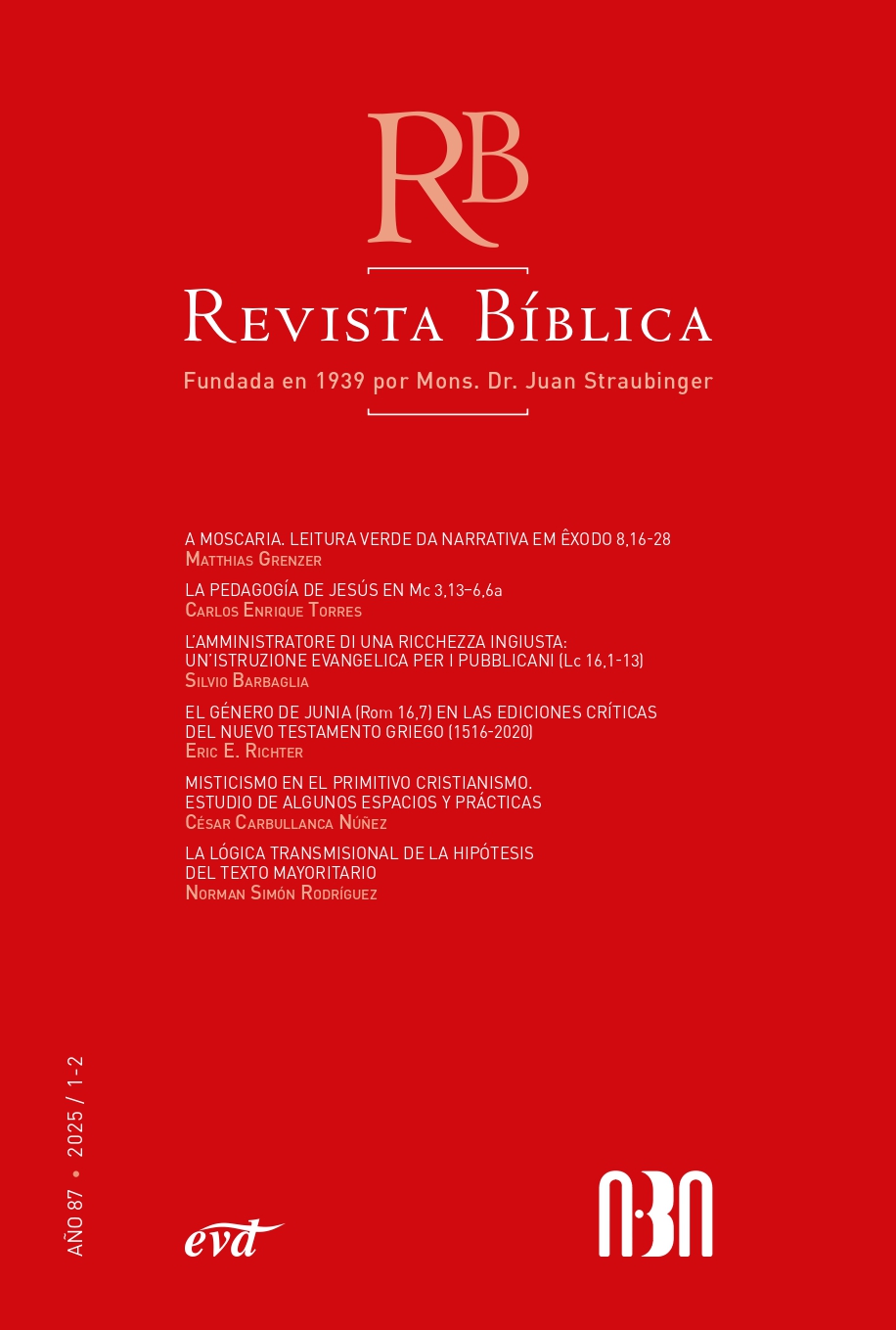La pedagogía de Jesús en Mc 3,13-6, 6a
DOI:
https://doi.org/10.47182/rb.87.n1-2-2025432Keywords:
Gospel of Mark, Jesus, Twelve, pedagogyAbstract
The passage of the convocation of the Twelve in Mark’s Gospel tells us that Jesus called them together for a double purpose: “to be with Him” and “to send them out to preach.” From that moment on, the narrator presents Jesus close to the disciples and having a special relationship with them. The presence of these elements in the section 3:13-6:6a is what has led me to choose it as a field of study for this work, whose point of interest lies in seeing how the author presents the accompaniment of Jesus to the Twelve before sending them out to preach for the first time (Mk 6:7-13). It is a question of answering: In what way does Jesus form the disciples at this stage? What is his pedagogy?
References
Balz, H., “???????”, en H. Balz – G. Schneider (eds.), Diccionario exegético del Nuevo Testamento, vol. II, Salamanca 2005, 1596-1597.
–, “????????”, en H. Balz – G. Schneider (eds.), Diccionario exegético del Nuevo Testamento, vol. II, Salamanca 2005, 1966-1975.
Bartolomé, J. “El discipulado de Jesús en Marcos: Motivo y metodología de un modelo evangélico de vida cristiana”, Estudios Bíblicos 51 (1993) 511-530.
–, “Jesús de Nazaret, formador de discípulos. Motivo, método y meta de la pedagogía de Jesús según el evangelio de Marcos”, Salesianum 69 (2007) 453-476.
Batto, B., “The Sleeping God: An Ancient Near Eastern Motif of Divine Sovereignty”, Biblica 68 (1987) 153-177.
Blount, B., “Jesus as Teacher: Boundary Breaking in Mark`s Gospel and Today`s Church”, Journal of Bible and Theology 70 (2016) 184-193.
Cave, C., “The Parables and the Scriptures”, New Testament Studies 11 (1965) 374-387.
Delorme, J., El evangelio según san Marcos, Estella 1990.
Donahue, J. R., El Evangelio como parábola. Metáfora, narrativa y teología en los evangelios sinópticos, Bilbao 1997.
Evans, C., “A Note on the Function of Isaiah 6, 9-10 in Mark 4”, Revue Biblique 88 (1981) 234-235.
–, “The Function of Isaiah 6:9-10 in Mark and John”, Novum Testamentum 24 (1982), 124-138.
–, To See and Not Perceive: Isaiah 6.9-10 in Early Jewish and Christian Interpretation (Journal for the Study of the Old Testament Supplement Series), Sheffield 1989.
García Martínez, F., Textos del Qumrán, Madrid 1992.
Gerhardsson, B., “If We Do Not Cut the Parables Out of Their Frames”, New Testament Studies 37 (1991), 321-335.
Gnilka, J., El evangelio según san Marcos 1,1-8,26, Salamanca 1999.
Guijarro, S., Los cuatro evangelios, Salamanca 2010.
–, El camino del discípulo: seguir a Jesús según el evangelio de Marcos, Salamanca 2015.
Jeremías, J., Las parábolas de Jesús, Estella 2006.
Kirkland, J. R., “The Earlist Understanding of Jesus Use of Parables: Mark 4, 10-12 in Context”, Novum Testamentum 19 (1977) 1-21.
Kirschner, R., “Imitatio Rabinni”, Journal for the Study of Judaism 17 (1986) 70-79.
Kremer, J., “????”, en H. Balz – G. Schneider (eds.), Diccionario Exegético del Nuevo Testamento, Salamanca 2005, vol. II, 582.
Larsen, K., “The Structure of Mark’s Gospel: Current Proposals”, Currents in Biblical Research 3 (2004) 140-160.
Lohmeyer, E., Das Evangelium des Markus, Göttingen 1951.
Malbon, E. S., “The Jesus of Mark and the Sea of Galilee”, Journal of Biblical Literature 103/3 (1984) 363-377.
Marcus, J., The Mystery of the Kingdom of God (SBL Dissertation Series 90), Decatur 1986.
–, El evangelio según san Marcos 1-8, Salamanca 2010.
Martínez Higueras, M., Haced discípulos. El discipulado en el evangelio de Mateo a la luz de la literatura rabínica, Madrid 2020.
Mascilongo, P., “Ma voi, chi dite che io sia?” Analisi narrativa dell’identità di Gesù e del camino dei discepoli nel Vangelio secondo Marco, alla luce della “Confessione di Pietro (Mc 8,27-30), Roma 2011.
Mateos, J. – Camacho, F., El evangelio de Marcos. Análisis lingüístico y comentario exegético, Córdoba 1993.
Miquel, E., “Para que no entiendan: discurso resistente disfrazado en Mc 4,1-34”, Salmanticensis 66 (2019) 51-85.
Müller, P., “?????”, en H. Balz – G. Schneider (eds.), Diccionario Exegético del Nuevo Testamento, vol. I, Salamanca 2005, 666.
Nagel, P., “The Theological Significance of the Isaiah Citation in Mark 4,12“, HTS Teologiese Studies/Theological Studies 72(4) (2016) 1-7.
Navarro Puerto, M., Marcos, Estella 2006.
Painter, J., “When is House Not Home? Disciples and Family in Mark 3,13-35”, New Testament Studies 45 (1999) 498-513.
Peisker, C., “Miszellen: Konsekutives ??? in Markus 4.12”, Zeitschrift für die neutestamentliche Wissenschaft 59 (1968) 126-127.
Schnek, R., Isaiah in the Gospel of the Mark 1-8 (Bibal Dissertation Series 1), Vallejo 1994.
Schneider, G., “?????”, en H. Balz – G. Schneider (eds.), Diccionario Exegético del Nuevo Testamento, vol. I, Salamanca 2005, 155-156.
Taylor, V., Evangelio según San Marcos, Madrid 1979.
Tolbert, M., Sowing the Gospel. Mark’s World in Literary-Historical Perspective, Minneapolis 1989.
Van Gennep, A., Los ritos de paso, Madrid 2008.
Wilkins, M. J., “Brother, Brotherhood”, en D.N.Freedman (ed.), The Anchor Bible Dictionary, vol. 1, 1992, 782-783.
Published
How to Cite
Issue
Section
Copyright (c) 2025 Revista Bíblica

This work is licensed under a Creative Commons Attribution-NonCommercial-ShareAlike 4.0 International License.




